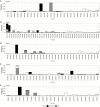The protected tree Dimorphandra wilsonii (Fabaceae) is a population of inter-specific hybrids: recommendations for conservation in the Brazilian Cerrado/Atlantic Forest ecotone
- PMID: 32277237
- PMCID: PMC7304468
- DOI: 10.1093/aob/mcaa066
The protected tree Dimorphandra wilsonii (Fabaceae) is a population of inter-specific hybrids: recommendations for conservation in the Brazilian Cerrado/Atlantic Forest ecotone
Abstract
Backgrounds and aims: Dimorphandra wilsonii Rizzini, a critically endangered and protected tree, has a restricted distribution in the ecotone between the Cerrado and the Atlantic Forest in south-eastern Brazil. In this area, it co-occurs with D. mollis Benth., a common tree from the Cerrado, and D. exaltata Schott., a rare tree from the Atlantic Forest. Previous studies of D. wilsonii indicated heterozygosity excess at the individual level. Field observation of some intermediate phenotypes between D. wilsonii and both congeners suggests hybridization of D. wilsonii with D. mollis and/or D. exaltata. Here, we tested the hypothesis that D. wilsonii may have originated from hybridization between D. exaltata and D. mollis. We also performed cytogenetic analysis to examine if the heterozygosity excess could be explained by polyploidy in D. wilsonii.
Methods: We evaluated the genetic diversity and population structure of D. wilsonii using 11 nuclear simple sequence repeats (SSRs) genotyped in 152 individuals sampled across the taxon's range. We performed comparative genetic analyses using overlapping SSR markers between D. wilsonii and previously published SSR data in D. mollis and D. exaltata to subsequently perform a series of allelic comparisons, multivariate and Bayesian analysis.
Key results: Our results suggest that D. wilsonii individuals are most likely to correspond to F1 hybrids between D. exaltata and D. mollis. Cytogenetic analysis indicated that D. wilsonii is diploid with the same chromosome number as D. mollis (2n = 2x = 28).
Conclusions: Our study raises questions about the taxonomic status and the evolutionary future of D. wilsonii. We suggest that the conservation and management strategy for D. wilsonii should be revised and that it should take into account both parental Dimorphandra species in the ecotone, with special emphasis on the threatened D. exaltata. Finally, this study highlights the value of genetic information for the design of conservation strategies.
Keywords: Dimorphandra; Dimorphandra wilsonii; Atlantic Forest; Cerrado; conservation genetics; ecotone; hybridization.
© The Author(s) 2020. Published by Oxford University Press on behalf of the Annals of Botany Company. All rights reserved. For permissions, please e-mail: journals.permissions@oup.com.
Figures





Similar articles
-
Naming Potentially Endangered Parasites: Foliicolous Mycobiota of Dimorphandra wilsonii, a Highly Threatened Brazilian Tree Species.PLoS One. 2016 Feb 24;11(2):e0147895. doi: 10.1371/journal.pone.0147895. eCollection 2016. PLoS One. 2016. PMID: 26910334 Free PMC article.
-
Development of microsatellite markers for Dimorphandra mollis (Leguminosae), a widespread tree from the Brazilian cerrado.Am J Bot. 2012 Mar;99(3):e102-4. doi: 10.3732/ajb.1100413. Epub 2012 Feb 16. Am J Bot. 2012. PMID: 22343542
-
Genetic data improve the assessment of the conservation status based only on herbarium records of a Neotropical tree.Sci Rep. 2019 Apr 5;9(1):5693. doi: 10.1038/s41598-019-41454-0. Sci Rep. 2019. PMID: 30952869 Free PMC article.
-
Nodulation in Dimorphandra wilsonii Rizz. (Caesalpinioideae), a threatened species native to the Brazilian Cerrado.PLoS One. 2012;7(11):e49520. doi: 10.1371/journal.pone.0049520. Epub 2012 Nov 19. PLoS One. 2012. PMID: 23185349 Free PMC article.
-
Ecotones as Windows into Organismal-to-Biome Scale Responses across Neotropical Forests.Plants (Basel). 2024 Aug 27;13(17):2396. doi: 10.3390/plants13172396. Plants (Basel). 2024. PMID: 39273880 Free PMC article. Review.
Cited by
-
Genomic signatures of ecological divergence between savanna and forest populations of a Neotropical tree.Ann Bot. 2023 Nov 23;132(3):523-540. doi: 10.1093/aob/mcad120. Ann Bot. 2023. PMID: 37642427 Free PMC article.
-
From forest to savanna and back to forest: Evolutionary history of the genus Dimorphandra (Fabaceae).J Plant Res. 2024 May;137(3):377-393. doi: 10.1007/s10265-024-01523-6. Epub 2024 Feb 19. J Plant Res. 2024. PMID: 38369599
-
Expansion of the rare Eucalyptus risdonii under climate change through hybridization with a closely related species despite hybrid inferiority.Ann Bot. 2022 Jan 8;129(1):1-14. doi: 10.1093/aob/mcab103. Ann Bot. 2022. PMID: 34351372 Free PMC article.
-
Hybrid zone of a tree in a Cerrado/Atlantic Forest ecotone as a hotspot of genetic diversity and conservation.Ecol Evol. 2022 Jan 22;12(1):e8540. doi: 10.1002/ece3.8540. eCollection 2022 Jan. Ecol Evol. 2022. PMID: 35127043 Free PMC article.
-
Advances in Legume Systematics 14. Classification of Caesalpinioideae. Part 2: Higher-level classification.PhytoKeys. 2024 Apr 3;240:1-552. doi: 10.3897/phytokeys.240.101716. eCollection 2024. PhytoKeys. 2024. PMID: 38912426 Free PMC article.
References
-
- Abbott RJ. 2017. Plant speciation across environmental gradients and the occurrence and nature of hybrid zones. Journal of Systematics and Evolution 55: 238–258.
-
- Abbott R, Albach D, Ansell S, et al. . 2013. Hybridization and speciation. Journal of Evolutionary Biology 26: 229–246. - PubMed
-
- Aksoy S, Almeida-Val VMF, Azevedo VCR, et al. . 2013. Permanent genetic resources added to molecular ecology resources database 1 October 2012–30 November 2012. Molecular Ecology Resources 13: 341–343. - PubMed
-
- Allendorf FW, Leary RF, Spruell P, Wenburg JK. 2001. The problems with hybrids: setting conservation guidelines. Trends in Ecology and Evolution 16: 613–622.
Publication types
MeSH terms
LinkOut - more resources
Full Text Sources

